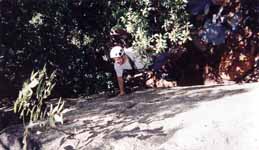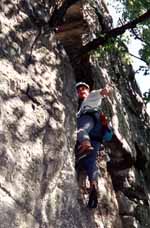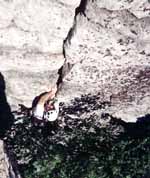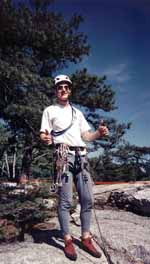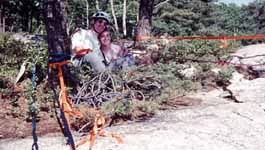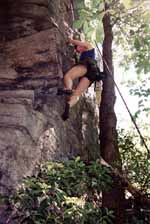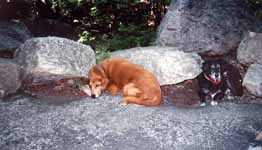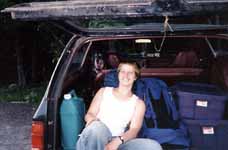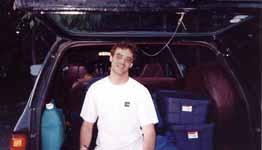Rock Climbing --- 5/28/1999 - 5/31/1999 --- Peter's Kill
YAJS (Yet Another Jeff Story): First Lead
Executive Summary -- Memorial Day Weekend; climbing at the Gunks; My first (and second) trad lead. For those not familiar with climbing terms there is a Frequently Asked Questions section at the end.
Memorial Day Weekend 1999. My long awaited trip to the Gunks is finally at hand. Climbing in the DC area is cool, but there is something special about climbing back at my old stomping grounds.
Friday afternoon I leave work as early as possible. Liz, Jamie and I meet up and drive four hours to Scranton, PA. We spend the night at a Day's Inn and enjoy a wonderful free breakfast Saturday morning -- a donut, bagel, and cheerio buffet similar to those served in the finest hotels in Europe. Around 10am Saturday morning we arrive in New Paltz and get our first glimpse of the miles of cliff which await us. I point at the cliffs and excitedly tell Mandel and Lance that we are going climbing. They continue to sleep in the back of the car, but demonstrate their enthusiasm by sleeping in an enthusiastic way.
"Do we climb up or down?"
- Lisa
We pull into the Peter's Kill parking lot and meet Sarah, her sister
Lisa and Scott. Sarah has shaved her long blonde hair and attempted
to dye the remaining stubble green. She looks sufficiently hardcore.
Lisa is looking forward to her first time climbing with nervous anticipation.
Scott isn't climbing because of an injured elbow, but makes a wonderful
photographer and anchor slave. We head over to the large chimney to the
right of Sheep's Roof.
The chimney allows us to set lots of climbs. A rope down the center allows climbing each face or the two faces together. Another rope to the right gave access to a large crack system. Good climbing was had by all.
"I went to the right from there."
"Ok, I'm moving right... ...Now what?"
"That's where I got stuck."
"Yeah, I'm stuck."
"Maybe you should have gone left."
- Liz and Jamie
After a warm up climb I decided it was time to try leading something.
I racked up my gear -- a full set of rocks (1 to 10), a set of hexes
on spectra (4 to 11 with doubles of 4 to 6), three swedges (4 to 6),
20 Omegalite wiregates, 10 sewn slings, a cordelette, and a few long
slings and locking biners. I need some tricams and SLCDs, but the
rack is sufficient right now. The climb I led ran right between the
two ropes we had set. The first half was pretty easy. All of the
placements were no-hands stances. The whole climb was only about
55' tall, but just for fun we decided to turn it into a multipitch.
I set an anchor at the obvious ledge 25' up then belayed Sarah up to
me.
"I wasn't sitting on the tree. It was in my way and I
brushed against it while climbing past."
- Sarah
The second half of the climb was tougher. It was slightly overhanging
and I quickly started to pump out while placing pieces. Getting faster
at placing gear seems pretty critical. The sun beat down as I neared
the top. The overhang was consistent and allowed no rest for weary
arms. The last two pieces went in very quickly and I found myself sitting
atop the cliff. After building an anchor, I belayed Sarah up the "second
pitch" of the climb. We enjoyed the view, posed for pictures and replayed
every move of the climb. It was a solid 5.5/5.6 climb and fairly sustained
for the last 20' or so. The grin on my face resembled a #4 camelot.
"Ok. Maybe I did sit on the tree, but not for very long."
- Sarah
The rest of the day wound down with some additional climbing, and a
lovely bark and howl fest by Mandel and Lance. One nice thing about
climbing at Peter's Kill -- nobody else there to hear the dogs. Even
though the Mohonk parking lots were full for the holiday weekend, we
didn't see another climber at Peter's Kill.
Saturday night we drove to Poughkeepsie to spend the night at Sarah's house. We polished off two pounds of pasta and went to sleep (all except for Sarah who accompanied her little sister Jenny to Denny's at 3am). Luckily Mandel and Lance never saw the skunk we watched in the back yard.
Rising reasonably early the next morning we drove to the back side of Mohonk to climb at Lost City. Even the overflow parking lot was nearly full, but the cars must have belonged to hikers. We hardly saw anyone out at Lost City. We set the climbs Off Width Her Foot and Eagle Shit (that's what we call them, I don't know the real names). Both of which proved difficult. I managed to get up Off Width Her Foot without falling for the first time ever (having tried it twice before in years past), but was not so successful with the easier Eagle Shit. Perhaps everyone was tired because the climbs proved much better at knocking off climbers than they should have been. Off Width Her Foot tried again to steal some gear. After neatly grabbing Fred's toprope anchor last year, it almost snuck some of Scott's quickdraws this day. But we were too smart and didn't donate any gear to the climb.
"If people catch you using your knee, tell them that you
are doing a knee-bar. It sounds better that way."
- Jeff
I needed to lead another climb, so I decided to try my hand at
Eagle Land. This is a reasonably easy climb with only one difficult
section, a 5.7 crux move. It is a fairly easy climb to lead because
all of the protection can be placed from no-hand stances. After topping
out I slung the big boulder and clipped the nut that Dave fixed
in 1997. Sarah followed me up and we sat for a few minutes and watched
the Turkey Vultures circle.
We left Lost City before the sun set. Gotta love those long summer days. It was a bit confusing for me, because the only way I've ever hiked out of Lost City was by following Mandel's eyes glowing in the light of my headlamp. The whole daylight thing was a new experience.
Sunday night we went to the DEC campground on route 299. It was crowded, but two people were nice enough to allow us to share their quiet campsite near a creek. We ate lots more food and went to sleep.
Monday morning Liz, Jamie, and Scott departed for their respective homes. Sarah and I hadn't quite had enough yet, so we drove to Peter's Kill for one last climb. We set a toprope on Hop To It and let that climb kick our butts. We each finally had to skip the crux move at the start of the climb. That was particularly disappointing for me because I had done the climb last year. Must climb more. Must get stronger.
When setting the toprope on Hop To It we managed to fix a #8 rock. It was very frustrating because the rock was totally loose and moving inside the crack, we just couldn't find a spot wide enough to get it out. Both of us played with the piece for quite a while. Finally I went back to my car and got the big nut tool (aka tire iron) and was able to clean the piece with it.
Even though we got an early start and only did one climb, it was already well past noon. I had a long drive ahead, so we decided to pack up the climbing gear and eat some lunch and some ice cream. Then I took Sarah home and started to drive back to DC.
When I reached the NY/PA border my Dodge overheated. I watched the temperature gauge moving rapidly towards the red zone as I pulled into a conveniently placed rest stop. By the time I got the engine turned off the radiator was venting through the pressure cap and the overflow tank was boiling. So I had some time to kill while waiting for the engine to cool down. I took the dogs for a walk, sorted my climbing gear, repacked my camping gear, inspected my slings for wear, removed the spilled dog food from my duffle bag, and sorted the recyclables and compostables out of the trash. It was a good thing the engine finally cooled down, about all I had left to do was alphabetize the contents of my glove compartment.
After topping off the anti-freeze and the engine oil I was able to drive without the car overheating... if I slowed down up the hills... and if I ran the heater full blast the entire trip. So between the initial hour waiting for the engine to cool and the slow driving, I got home fairly late. But at least I was able to turn off the heater in the car an hour after sunset when the night air cooled down a bit.
And now here I am at home. Flipping through climbing catalogs looking for the next addition to my rack. Climb on. Lead on.
Frequently Asked Questions
Q1: What the heck are the Gunks?
A1: The Shawangunks Mountains. One of the most popular rock climbing destinations on the East coast. Most of the climbing is in the Mohonk Preserve, but some can be found elsewhere (like the Peter's Kill section of Minnewaska State Park).
Q2: What is a lead climb?
A2: When rock climbing it is always a good idea to be tied into a rope which can keep you from hitting the ground if you fall. This is to "belay" or secure with a rope. The length of rope let out is controlled by your climbing partner who moves the rope through a belay device which creates friction sufficient to hold a climber. In addition to being secured by the belayer, the rope must be attached to the cliff. There are several ways to do this. One way is called toproping. An anchor is built at the top of a cliff and the climber climbs up to the anchor. Toprope climbers are limited to cliffs no taller than half the length of the rope (or the full length of the rope if the belayer is at the top of the cliff). One advantage to toproping is that you can attach the anchor to large trees and take plenty of time to make the anchor is very secure. Another advantage to toproping is that when you fall, you only fall enough distance to take the slack out of the system (generally a foot or two).
But some cliffs are much taller than one rope length. This is where lead climbing is essential. When lead climbing, the climber places an anchor in the rock, climbs past it, and places another anchor further above. Anchors can be attached to bolts drilled in the rock (this is called sport climbing), or to pieces of aluminum which are wedged into cracks by the lead climber, then removed by the second climber when the second follows the lead (this is called traditional or trad climbing). If you fall when lead climbing, you fall twice the distance that you are above your last anchor plus any slack in the rope. At least that is how far you fall if your last anchor holds. Lead falls can produce very large forces and can rip poorly placed anchors right out of the rock.
Q3: What is a rack?
A3: A rack is the gear that a lead climber carries to build anchors when climbing. My rack consists of Black Diamond Hexcentrics (hexes) and Wild Country Rocks with a few Black Diamond Swedges thrown in. Hexes are asymmetrical hexagons made out of aluminum. Mine vary in size from about 21mm (#4) to 89mm (#11). Rocks are smaller wedge shaped pieces of aluminum which range in size from 7mm (#1) to 31mm (#10). Swedges are tiny brass/steel wedges which are 8mm and smaller. Lots of other gear can be purchased to augment a rack including spring-loaded camming devices (SLCDs) which use springs to wedge in cracks and expand when pulled so they hold tighter for greater loads.
Racks also need plenty of nylon or spectra slings (like seatbelt webbing) and carabiners to attach the rope to the anchor pieces. In addition, climbers carry plenty of other junk like a belay device, chalk bag, nut tool (steel tool used to remove pieces which are wedged a bit too tightly), and prussiks (loops of rope which can be used to ascend larger ropes).
A trad climber will never sneak up on you. All that metal makes them clank when they move. A trad climber looks like someone who was caught in the hardware section of a Home Depot when a bomb exploded.
Q4: What do these terms mean -- 5.x, no-hands stance, chimney, pitch, #4 Camelot?
A4: 5.x - The Yosemite Decimal System for rating climb difficulty. Ratings should always be taken with a grain of salt and tend to vary between regions. I generally can get up a 5.9 or easy 5.10 climb on toprope (which is much easier than leading). 5.0 is very easy, but still requires a rope to keep the climber alive in the event of a fall. The hardest grade ever climbed by anyone is currently 5.14 (the ratings used to end at 5.10 but climbers kept getting better and shoes kept getting stickier). 4.x climbs can be done without a rope and 6.x climbs require aid (pulling on gear to get past hard parts). A trad climber only uses gear for protection in the event of a fall, all movement is done using only the cliff face for holds (this is known as free climbing).
No hands-stance - A great spot to stop and rest. The climber can let go with both hands simultaneously and still not fall off the cliff.
Chimney - Two opposing faces of the cliff close enough together so that one foot can be on each face.
Pitch - A section of a climb one rope length tall. When climbing a multipitch route, the leader must build a large anchor at the end of the pitch and belay the second climber up to that anchor. Then the second climber can lead the next pitch or give the gear (which was retrieved by the second when following the leader's route) back to the first climber who will then lead the next pitch.
#4 Camelot - A big SLCD.
Q5: Why climb cliffs? Are you crazy or what?
A5: This is hard to explain. Part of it is just the fun of being outside on a beautiful day gazing at the view from the top. Part of it is the physical and mental challenge of climbing a particularly tough section. Part of it is the wonderful opportunity to play with lots of gear.
Certainly it is more dangerous than sitting at home reading a book. But in no other activity are you ever so completely focused on safety. As a result, accidents are rare. Statistically, it is more dangerous to drive to the cliffs than to climb them (ok, I made that up, but it might be true).
Q6: How are climbs named? Drunk monkeys throwing darts at a dictionary?
A6: Something like that. You know, Drunk Monkeys Throwing Darts would make a good name for a climb.
Q7: Why run the heater when your car overheats?
A7: A car's radiator moves heat from engine coolant into the outside air. The heater moves heat from engine coolant into the passenger compartment. So the heater is just a small radiator. Turning it on increases the capacity of a car's cooling system. Unfortunately, when the car is overheating on a hot day, you don't usually want more heat in the passenger compartment.
Q8: Does that really work?
A8: Yup. I could watch the temperature gauge drop after turning on the heater. Turning off the heater (which I tried every 30 minutes or so) caused the car to overheat until the sun set and the outside temperature dropped about 15 degrees.
Q9: Would you have really alphabetized the contents of your glove compartment?
A9: No. That wouldn't be a particularly logical organization scheme. I prefer to keep the most frequently used stuff on top.
